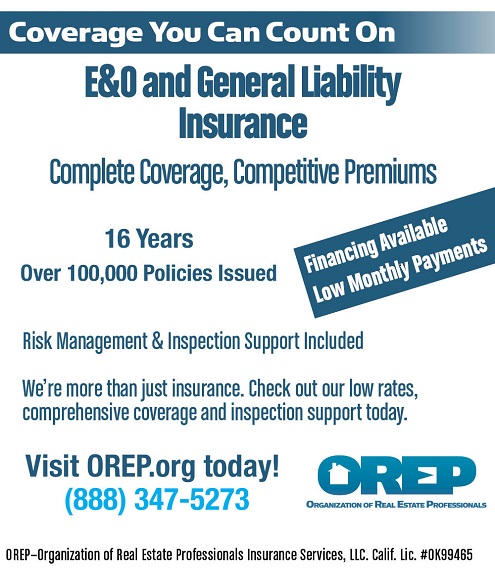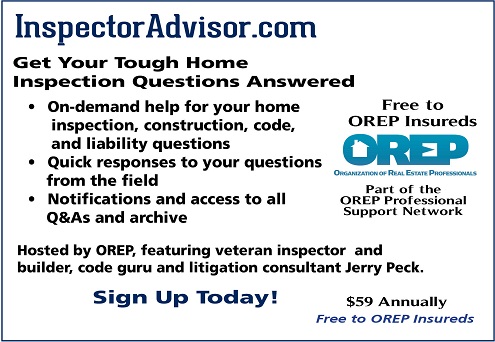 |
> E&O You Can Count On E&O/GL Insurance for Home Inspectors- *Broad Coverage *$1,000 minimum premium (choice of limits/deductibles) Shop OREP Now! |
Editor’s Note: This story appears in Working RE Home Inspector’s NEW September Print Edition. OREP E&O insureds receive guaranteed delivery of each print issue along with many other valuable business benefits.
> Now reaching 20,000+ Home Inspectors in Print and Online!
Meth Testing: What to Look For
By Julie Mazzuca, Founder, Meth Lab Cleanup Company (MLCC)
Thinking about offering meth testing as part of your home inspection? Here is what to look for in a comprehensive training course.
Many of the properties that are identified as former meth labs are discovered through means other than law enforcement. Contamination is often discovered during a property assessment in response to health complaints by occupants, information from neighbors regarding a prior occupant or as part of a real estate transaction. Home inspectors provide the first independent evaluation of the condition of a home prior to a sale. Meth testing is becoming more and more popular as the numbers of contaminated properties rise and homebuyer awareness
increases.
Primarily, a meth testing course should provide an overall understanding of meth production, regulations, safety and
health hazards and protective measures to take while on-site. It is vital that course participants learn how to visually assess a suspect property, how to sample for meth, how to understand the results and appropriately document the meth inspection. Here is what to look for when evaluating a comprehensive meth testing course. A good course will address each of the following segments.
Methamphetamine Production
Although meth is not the only drug manufactured in clandestine labs, meth labs are the most common. A segment on the “cooking” of meth should describe the variety of chemicals used to manufacture and how they are obtained. Further discussion should demonstrate that although many of these chemicals are commonly found in households and can be “safe” if used appropriately, their inherent dangers are increased when used inappropriately or in combination with other chemicals during the meth production process.
(story continues below)
(story continues)
Hazards of Active/Inactive Labs
There should be a segment on the hazards of clandestine drug laboratories. Although a functioning drug lab presents the greatest risk of adverse health effects for occupants, some residual contamination created from repeated “cooks” can persist long after all production has ceased. The release and hazards of ingredient chemicals should be outlined in addition to how these chemicals settle into a residence.
Human Health Hazards
A segment on the toxicity of meth lab production chemicals should be included. This segment must discuss how chemicals may enter the body, symptoms and short and long term exposure hazards.
Personal Protective Equipment
A segment on the use of proper personal protective equipment (PPE) must be included. It is important to understand potential site hazards, what PPE is appropriate and how to implement proper protective measures.
Meth Screening
A course segment on the visual assessment of a residence, both interior and exterior must be provided. Meth production indicators should be identified to include stained coffee filters, syringes, plastic hosing, disabled smoke detectors, weapons, distressed vegetation, burn piles, pornography, and drug paraphernalia.
Meth Sampling
Sampling is performed to establish the presence or absence of methamphetamine. The different types of methamphetamine sampling, how to perform sampling and how to interpret results are skills critical for meth home inspection services.
Remediation
A segment on meth lab “cleanup” methods is important in providing
the inspector a general understanding of initial meth lab
component removal and the process of property remediation.
(story continues below)
(story continues)
Reporting
After completion of interior and exterior screening, the inspector must verify to the client and/or property owner that the screening was completed according to recognized standards for screening. A segment on reporting that outlines appropriate documentation is a must.
Regulations
Many home inspectors may be under the impression that they are not allowed to offer meth testing services. The state of Utah, one of the most progressive in clandestine drug lab regulation,has recently amended its standards to allow for “non-confirmation sampling.” This means collecting samples by any party other than a certified decontamination specialist. These results can be provided to the local health department and then the
owner of record is encouraged to obtain confirmation sampling, performed by a certified decontamination specialist, within 10 days of notice. In addition, many health departments now acknowledge sample results from do-it-yourself meth residues test kits.
A careful review of the applicability of home inspection meth testing is critical. It is important that you know if you are doing business in a state that regulates testing, remediation and/or disclosure. Keep in mind, some county and/or cities have their own cleanup ordinances. A segment that provides a resource for state clandestine drug lab standards is essential.
About the Author
Julie Mazzuca has been designing both classroom and online training courses for Meth Lab Cleanup
Company since 2004. Julie has signature authority on all MLCC clandestine drug lab assessments and decontamination documentation; over 6,000 to date. Contact her at info@methlabcleanup.com
or (208) 683-1974.
> Free Webinar:
Claims and Complaints: How to Stay Out of Trouble
Available Now
Presenter: David Brauner, Senior Insurance Broker OREP
David Brauner, Senior Broker at OREP, shares insights and advice gained over 20+ years of providing E&O insurance for inspectors, showing you how to protect yourself and your business. Watch Now!
Note: The September 2017 issue of Working RE Inspector is mailing now to over 20,000 home inspectors nationwide. OREP Insureds enjoy guaranteed delivery of each print magazine and many more benefits.




